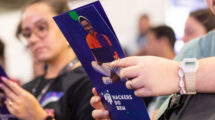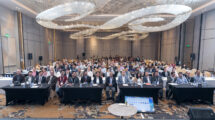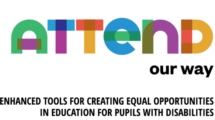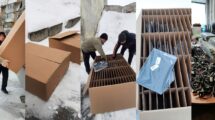CONNECT Magazine met Dr Gihan Kamel, Principal Scientist at the Synchrotron-light for Experimental Science and Applications in the Middle East (SESAME), whose keynote will close TNC22 in Trieste on Thursday 16 June 2022. Dr Kamel talked to us about the role of SESAME not only as a pioneer research centre, but also as a bridge for peace and a vehicle for economic growth, and how scientific research can bring people from diverse backgrounds together to achieve a common goal.
Dr Kamel had you ever come across GÉANT and our flagship conference TNC?
Yes, indeed. There are some collaboration schemes between GÉANT and SESAME concerning connectivity and scientific computing projects which comprise various iterations of EUMEDCONNECT and AfricaConnect projects.
In your TNC22 keynote you talk about what makes SESAME an exceptional scientific facility, explore the human side of scientific collaboration and how research can help overcome differences. Could you share with our audience some highlights of your talk?
Understanding the Middle East diversity is very puzzling to many, with the coexistence of several cultures, common traditions, in addition to belief systems. All these mentioned are sculpted by history, geography, nationality, and religion, among other aspects. In reality, economic and political crossroads do emerge due to the vast geographical features. But fundamentally, there are still many debates and scepticism regarding the science and technological advances in the Middle East – being such a boiling region on the threshold of war most of the time, the key player is peace. Currently, SESAME brings together eight members: Cyprus, Egypt, Iran, Israel, Jordan, Pakistan, Palestine, and Turkey.
SESAME has had a huge impact on the scientific community and social economic development in the Middle East. It is modelled on the European Organisation for Nuclear Research, which was established at the end of the Second World War to unite European scientists. I think that collaborative science is about resources and complementarities. The way that we help and support each other depends mainly on our perspectives. Officially launched in 2017 under the auspices of UNESCO, it is based in Jordan. Being the only synchrotron facility in the Middle East and neighbouring regions, it was conceived with two main objectives: to foster the scientific excellence and interdisciplinary research laboratories and to serve as a bridge for peace and co-existence in a region long characterised by tension. For instance, the countries of the region have common links in developmental health challenges and a wealth of archaeological and cultural heritage. Thus, it seemed rational to bring together scientists to simply follow the conceptual approach of “science for peace”.
In addition, the large-scale emigration of skills and knowledge of what is well known as the human capital flight or the brain drain challenge which imposes a dramatic influence on both people and countries as it has a socio-economic impact, as well as the women in science one and how to overcome it, both remain two major challenges for the entire region.
Therefore, SESAME is considered to have a great responsibility to conduct intense awareness and promoting within the Middle East to scientists, leaders, policymakers, and the general public. I believe that it is of paramount importance to emphasise SESAME as a model for “science for peace” – and how does science serve as a neutral power, complementing political diplomacy.
In a TEDxCERN talk, you say that you have an interest in breaking through science (and other types) borders and explain that these are defined by labels. Could you give us some examples?
Labels are so many, including nationalities, languages, religions, and genders – this in turn, impose different considerations and ideological behaviours which sometimes are intolerable and biased. We share 99.9% of our genes with each other, which means that we share almost the same diseases, pollution, energy, and climate change problems that impose different impacts on our economies, food security, and disaster management.
I believe that labelling is quite toxic and unfair, and to overcome such a labelling system, we need to avoid narrow-mindedness and prejudices. Science, in my opinion, is such a tool that never fails to stand as a very efficient language that we can all use to overcome all our differences and labels. Science is labels-free, neutral, and fair.
For example, it is really inspiring to see many politically conflicting groups of people gathering in one place, sharing scientific ideas and future plans, sharing hopes and optimism for the mutual benefit relying only on scientific collaboration – putting aside – even if for a short time – the conflicts, the wars, and the differences.
Another label – that unfortunately still dominates many scientific societies even in the developed countries – is the women in “discipline” terminology – be it women in science, women in engineering, etc. I believe that such a concept would not be that public unless it represents a real and persisting challenge.
You were the first woman scientist to join SESAME. What did it mean to you? What advice would you give to young women who aspire to work in your field?
I was alerted at an early age to the discrimination imposed by the wider society and some of the male teachers and professors I encountered, that women do not belong in science which should be left for men. In a way, my scientific ambition was quite a rebellion in addition of being merely a choice of specialisation. Our culture ideals impose rigid obstacles on the role and capacity of women in the society. When I joined SESAME, I was – and still am – the only woman scientist in the place. It meant a huge challenge and a remarkable experience, one of a kind to me. I knew that I would have to work extremely hard, firstly to become as expert as possible in the field and, of equal importance, to rise above the biased as well as the flawed prejudgements.
To date, many women Arab scientists are still constrained. Many are only able to travel to other Arab countries, and not internationally. Thus, SESAME hands an opportunity to the women scientists in the Middle East to simultaneously maintain their ambition and tradition, and to break the unacceptable rules. And this is my mere advice to the young women, to break the unacceptable rules. To rise above all the differences and to compete without hate. Accompanied by patience, persistence, strength of will and self-discipline.
What’s around the corner for Dr Gihan Kamel?
Challenges. Further scientific challenges, and societal barriers to overcome, and more rules to break despite success and progress. We, scientists, are always looking for more problems to solve or experiments to play with.
Another emerging experiment is my new endeavour with the foundation with the African Light Source. No one can argue that Africa is facing many challenges. In this context, a synchrotron light source for Africa can play a crucial role in the region, for the African community and elsewhere, as SESAME did and is currently doing where the impact will robustly go beyond any “national” science, again with no borders and with no personal labels.
On the positive side, as women are trying, pushing, and applying to conduct research, training, or short fellowships at SESAME. I feel obliged to fully assist and support. So, along the queue, there are many scientific collaborations awaiting to be fulfilled.
Thus, I also consider it a personal mission to highlight and engage more African women in international collaborations and projects. More broadly, I urge young female students interested in science, technology, engineering to explore their horizons and not to be afraid to break societal rules that stand in the way of their scientific ambition.
This article is featured on CONNECT40! Read or download the full magazine here







